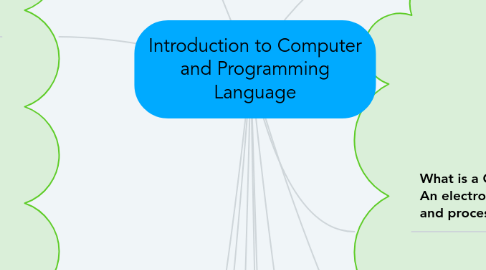
1. What is a Programming
1.1. Computer Programming `The art and scienceof designing and writting computer programs
1.2. Computer Program `A sequence of instructions written in a programming language to achieve a task/to solve a problem
2. Hardware Components of a Computer
2.1. CPU `Brains of a computer `Handless all instructions that we give to the computer `Most expensive, the more expensive, the faster is a computer
2.1.1. CPU Component `Control unit `Program counter `Registers `Arithmetic Logic Unit `Accumulator
2.2. RAM `Temporary memory `Volatile (information stored in it will be lost when electric power supply is turned off `Directly connected to the CPU, using memory cells unit
2.3. Secondary Storage Provides permanent storage for information
2.3.1. Example `Hard disks `Floppy disks `CD-ROMs `USB Flash Drives
2.4. RAM VS Secondary Storage
2.4.1. RAM/Main Memory/Primary Memory `Volatile Fast `Expensive Low capacity `Works directly with the processor
2.4.2. Secondary Storage/Secondary Memory `Nonvolatile `Slow Cheap Large capacity Not connector directly to the processor
2.5. Secondary Memory Devices
2.5.1. Main memory Information is moved between main memory and secondary memory as needed
2.5.1.1. CPU `
2.5.1.2. Hard Disk Secondary memory devices provide long-term storage
2.5.1.3. USB Flash Drives `Hard disks `Floppy disks `USB drives `Writable CDs `Writable DVDs
2.6. Input/ Output Devices
2.6.1. Digital Information `Computers store all the informationdigitally `Number, text, graphic and images, video, audio, program instruction `In some way, all information is digitized-broken down into pieces and represented as numbers
2.6.1.1. Representing Text Digitally `For example, every character is stored as a number, including spaces, digits and punctuation `Corresponding upper and lower case letters are considered as different character
3. Binary Numbers `Once information is digitized, it is represented and stored in memory using the 'binary number system' `A single binary digit (0 or 1) is called a bit `A byte consist of 8 bits `Each byte in main memory resides at a numbered located called its address
4. Storage Capacity `Every memory device has a 'storage capacity' indicating the number of bytes it can hold `Capacities are expressed in various unit
5. Portablility ~After compiling a Java program into bytecode, that bytecode can be used on any computer with a bytecode interpreter and without a need to recompile ~Bytecode can be sent over the Internet and used anywhere in the world ~This makes Java suitbale for Internet applications
6. Java Program Elements ~A Java program is made up of 'class definitions' ~A class definition must contain a 'header' and a 'body' ~A class contains zero or more 'methods' ~A 'methods' is a named section of code that also has a header & body -A method contains -program statements ~'Comments' are used to document the code, will not be interpreted -Single-line (starts with //) -Multi-line (enclosed by /* and */)
7. Application Software `Generic term for any other kind of sortware `E.g: Ms Word processor, Excel Spreadsheets, Web browsers, games
8. What is a Computer An electronic device that stores and processes data
8.1. Hardware `The physical, tangible parts of a computer `Keyboard, monitor, disks, wires, etc
8.1.1. Organization `Central Processing Unit(CPU) `Main memory (RAM) `Secondary Storages `Input/ Output Devices
8.2. Software `Programs (e.t. MS Word) and data `Intangible parts of a computer `Both of hardware and software form a tool that can be used to solve problems
8.2.1. Organization `System Software `Application Software
8.2.1.1. System Software `System programs keep all the hardware and software running togeher smoothly `The most important system software is the operating system (OS) `Controls all machine activities `Provides the user interface to the computer `Manages resources such as the CPU, memory & I/O `E.g: Windows 10, Unix, Linux, Mac OS
8.2.2. `In contrast to hardware, software is an abstract, intangible entity `Software can be categorized as system or application software `It consists of program and data to be used to perform certain tasks `A program is a sequence of simple steps and operations, stated in a precise language that the hardware can be interpret `The process of programming involve algorithm design & coding

